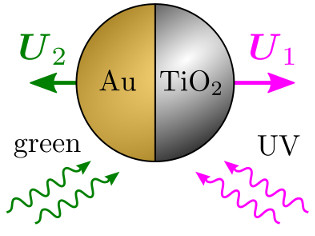Institute of Theoretical Physics @FUW

Propagating magnetic waves
The figure presents the "snapshots" of a propagating magnetic wave as taken
in two distinct magnets: (a) a ferromagnet, i.e. a magnet with its magnetic moments pointing in
the same direction (left panel), (b) an antiferromagnet, i.e. a magnet with
the magnetic moments pointing in the opposite direction (right panel).
Note that the magnetic wave was initially triggered in the middle
of a magnet presented in each panel; assuming that the interaction
between the magnetic moments is of the order of 100 [meV], the snapshots show the
amplitudes of the waves about 200 [fs] later. The result is a bit counter-intuitive:
whereas the (naively) rather conventional ferromagnetic wave propagates like a so-called
"quantum walker", the more complex antiferromagnetic wave resembles the well-known case
of a stone thrown into a pond.
[Figure adopted from P.Wrzosek et al., Phys. Rev. B 102, 024440 (2020)]

Active particles with light-switchable propulsion direction and reversible interactions
Sketch of the new catalytic mechanism proposed in the present Nature Communications paper. The particle is made of titanium dioxide with a gold-coated hemisphere. Its motion is induced by external illumination. Under green light, the particle moves towards the gold cap, but when exposed to UV light, it reverses its direction of motion and moves in the opposite direction.
[Source: H. R. Vutukuri et al., Nat. Commun. 11, 2628 (2020)]
Read more in the FUW press release: https://www.fuw.edu.pl/press-release/news6387.html
